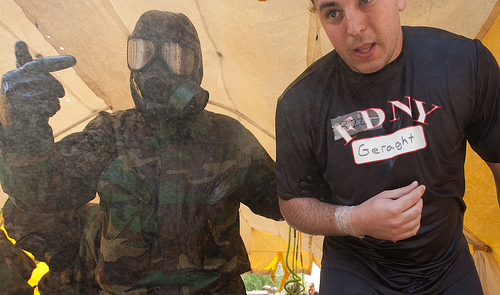U.S. Earns Low Marks on Bio-Response Report Card
10/13/2011 -
The first thing that stands out about thebio-response report card issued by the Bipartisan Weapons of Mass Destruction Terrorism Research Center (the WMD Center) is the number of red boxes marked F, indicating a “failure to meet expectations.” The second thing that stands out: There are no As. The U.S., for the most part, received good marks in response capabilities to small-scale attacks, but the report makes clear that the country does not have adequate measures in place to response to a large-scale biological event.
What would be a large-scale attack? The same amount of anthrax powder used in the 2001 attacks distributed in the ventilation system of the World Trade Center could have killed far more people than the 9-11 attacks, the report says.
The WMD Center enlisted the aid of subject-matter experts and 24 of the nation’s top biodefense, public health, and medical experts to assess the nation’s preparedness to respond to a biological attack. The report grades the country’s progress in various response capabilities from detecting an attack, responding to it, and tracing where it originated.
Methods of detection and diagnosis are improving, but funding shortfalls threaten to undermine improvements that have taken place on state and local levels. In almost all types of attacks, the country received failing marks in its ability to identify the source of a biological event. “Despite extensive research, a scientifically and legally validated attribution capability does not yet exist for anthrax or virtually any other pathogen or toxin,” the report states. The report also notes how past studies have shown it would be almost impossible to detect a facility being used to manufacture biological weapons, so early detection is crucial.
Many improvements have been made in information sharing and communication, thus meeting most expectations for small-scale attacks and minimal expectations for large-scale attacks. Some of these improvements come from CDC products and CDC capabilities, such as language translation, the “Communicating in the First Hours” initiative, and pre-scripted messages that can be used on TV and radio after an attack. The prescripted messages include alerts about biological, chemical, and radiological events, and suicide bombing. For most attacks, though, it’s still unlikely countermeasures could be dispensed to large portions of the population in 48 hours. Local agencies are working toward making it a reality, though progress has been "slow" and "uneven" (see "USPS Reductions Won’t Affect its Door-to-Door Anthrax Response Capability") .
The WMD Center says focusing efforts on large-scale events rather than worst-case scenario will generate the best return on investment. “These scenarios are more likely, but moreover, it is possible to improve these grades in the relative near-term,” the report states. Plugging these holes will in turn help improve grades for small-scale events as well.
